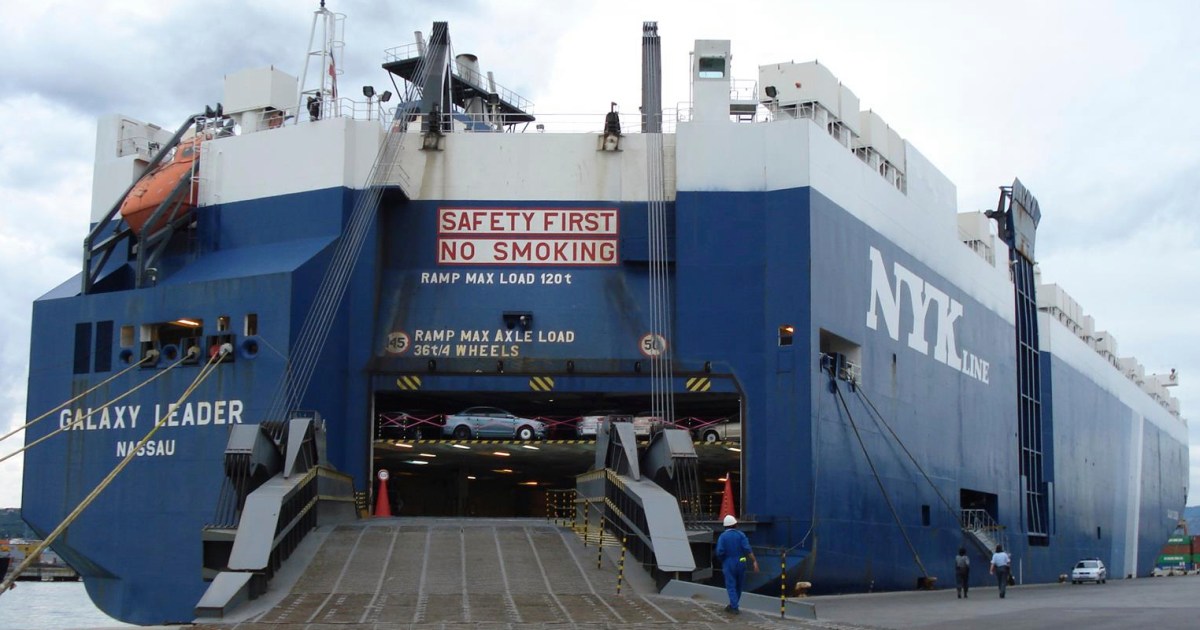
On Sunday, Houthi fighters a cargo ship is hijacked in the Red Sea off the coast of Yemen.
The 189-meter-long car carrier Galaxy Leader, traveling from Turkey to India, was intercepted by small speedboats and boarded by uniformed, armed personnel.
Other people rappelled from a helicopter onto the deck and ordered the crew to change course to the Yemeni port of Hodeida.
No shots were fired and the seized vessel was a civilian ship traveling between neutral countries. Still, the incident has the potential to trigger a serious escalation in the recent Israeli-Palestinian conflict.
In a worst-case scenario, it could be the first step in directly involving the United States and Iran in the war.
Houthi spokesman Yahya Sare’e confirmed that the ship was seized because it was “Israeli-owned,” in line with his earlier announcement that the group “would not hesitate to seize any Israeli vessel in the Red Sea or anywhere.” “that we can achieve.” Israel has denied any connection to the ship, although ownership records in public shipping databases suggest it belongs to one of Israel’s richest men.
Most of the Red Sea is wider than 200 km (124 miles), but its southern end, the Bab al-Mandeb Passage, is a narrow passage less than 20 km (12 miles) wide from the Yemeni island of Mayyun to to the coast of Djibouti Eritrea. More than 17,000 ships pass there every year. That’s almost 50 per day.
Many of them have legal status such as the Galaxy Leader, who flies the flag of the Bahamas operated by a Japanese companyand had a Bulgarian captain and a crew from at least five other countries, none of them Israel. In the complex world of shipping, ownership of a ship is less important than the ship’s flag, which indicates its country of registration, and its operating company.
There is a so-called “flag of convenience” in the Bahamas. It is a country with low taxes and less strict labor policies, enticing operators to register their vessels there. The operating company is the Japanese Nippon Yusen Kabushiki Kaisha, known as NYK Line, which operates 818 ships.
Among the nearly 1,500 ships that pass through the strait each month, there may be dozens that could be linked to Israel and are therefore vulnerable to further Houthi kidnappings.
Shipping must continue under all circumstances. So will all “Israel-affiliated” ships simply be at the mercy of the Houthis?
Probably not, but the options for preventing further kidnappings are limited to three: sending armed ships to escort commercial traffic, destroying or severely limiting the Houthi’s offensive capacity at sea, and persuading the Houthi to refrain from attacks.
The first option begs the question: who could provide armed naval patrols in the Red Sea?
Saudi Arabia and Egypt, the states bordering the Red Sea, have strong and sophisticated navies. But Saudi Arabia is in one uneasy ceasefire with the Houthisthat they don’t like to disturb. Egypt is trying to remain neutral and does not want to get into tensions with the Houthis. Israel cannot spare ships for this task.
The only force left to deal with the Houthi threat would be the US Navy.
Since October 7, the US has deployed large numbers of forces to the Middle East, focused on two Carrier Strike Groups (CSGs). CSG 12 in the Mediterranean is led by the newest and most modern nuclear-powered aircraft carrier, the USS Gerald R. Ford. CSG 2, currently in the Gulf of Oman, is led by the USS Dwight D Eisenhower. Each aircraft carrier is accompanied by a guided missile cruiser, two or three destroyers, and a support fleet such as tankers, storage ships, and mobile repair bases.
Each of the two CSGs has a clearly defined task: CSG 12 is supposed to monitor the greater Israel, Palestine, Lebanon, Syria and Iraq and act against any threats that could escalate the conflict. CSG 2 is there to monitor Iran and take action against it if the situation escalates.
The Eisenhower CSG is being held outside the Strait of Hormuz to signal directly to Iran that the US does not yet harbor hostile intentions. Iran’s supreme leader, Ayatollah Ali Khamenei, has made it clear that his country will continue to support Hamas and the Palestinian people, but does not want to go to war.
Thus, the CSG 2 demonstrates a less belligerent intent and remains in the Gulf of Oman, from where its aircraft could still reach targets in Iran if necessary, or could advance into the Gulf in the unlikely event that the US hits them should its threat want to escalate.
Outside of the CSGs, the US Navy also has individual ships that monitor Houthi missile launches. On October 19, the USS Carney shot down several Houthi missiles and drones targeting Israel.
Because all of these assets have specific tasks, American options are limited. The only ships that can be used to escort merchant shipping are those grouped around the amphibious carrier USS Bataan, which is currently south of Suez. A shift south would weaken the US’s ability to respond to escalation around Gaza.
That brings us to the second option. The Houthis are known for their willingness to take on even stronger enemies. If the US targets them directly, there could be a major escalation. Washington could ask Israel to attack Houthi ports with long-range missiles, but even that is risky.
This brings us to the third option, de-escalation.
It appears that Iran is once again the key. If the capture of the Galaxy Leader was an independent Houthi action not instigated by TehranThe US could engage in quiet diplomacy to persuade Iran to govern its proxy and prevent new hijackings.
This may be the most realistic solution, but only if everyone involved shows restraint.
It’s about a lot. Another hijacking could have a snowball effect, drawing other countries more actively into an already devastating conflict and pushing it to the point of no return.






Recent Comments